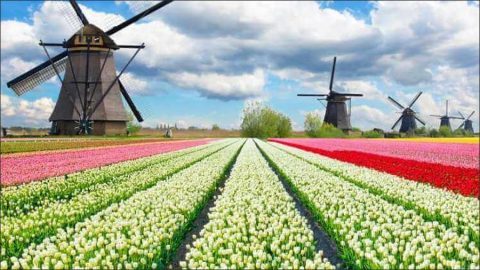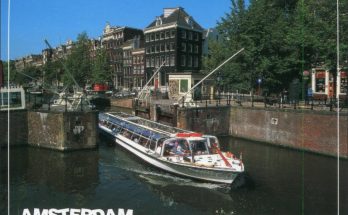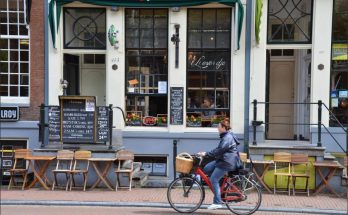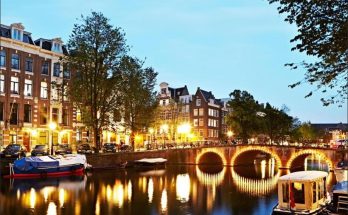Is Holland a land of wine and oil? The great American writer Motley once couched his opinion on our agriculture and cattle-rearing in the following typical terms: “Their cattle grazing on the bottom of the sea are the finest in Europe, their agricultural produce is of more exchangeable value than if Nature had made their land to overflow with wine and oil.” Leaving aside Motley’s metaphor on Dutch cattle as “grazing on the bottom of the sea,” I at once call attention to the fact that although our country yields a great many valuable products from its fertile soil, we cannot by any means reckon wine and oil to belong to our national treasures.
I shall try to demonstrate that Dutch soils are capable of showing excellent results in the intensive cultivation of a good many agricultural products. It is indeed the divergent geological character of these soils, which naturally contributes to the cultivation of such a great variety of produce. According to the condition of the soil and the occupations in connection with the same we discriminate between six main divisions.
Marine clays with farming and mixed occupations. These grounds are generally characterised by the more important agricultural activities. In some districts however we find a considerable number of smaller occupations which are chiefly concerned with those agricultural growths that involve much human labour, such as: potatoes, sugar-beets, onions, beans, etc., as well as with market-garden vegetables. Grasslands and arable lands are of varying proportions. Generally speaking, agriculture has attained a high degree of development upon marine clays.
Corn-growing on the other hand has diminished on them of late, with the exception of the marine clay soils in the province of Groninguen and some smaller districts in other provinces; it now occupies not more than a fourth or a third part of the ploughland. Besides grain and pulse a great variety of vegetation is being reared for commercial and industrial purposes, among which potatoes and sugar-beets have come to be the principal. The stoppage of food supply from abroad gave rise to potato-growing on an immense scale. Whilst before the war it covered an area of 400.000 acres, it now occupies 425.000 acres, viz. 345.000 acres for clay and sand potatoes used for consumption, and 80.ooo acres potatoes intended for factory use.
Fluvial clays with mixed occupations differ from the above lands not only as regards condition of the soil but as to the nature of the occupations as well. Since the large occupations were being divided more, the smaller ones have developed proportionally. Grassland preponderates here. Next to grain, potatoes and beets are extensively grown in the majority of these districts, especially by small farmers. Growths intended for commercial purposes are not much cultivated here.
Fruit-culture on the other hand is a special feature in orchards with grassland. Pasture lands are found in those districts where the soil is used almost entirely as grassland. The farms usually have an average extent from 37 1/2 to 75 acres. Larger as well as smaller ones are comparatively rare. The soil consists for the main part of low fens and clays. During the last few years ploughing up of grass-land has been done more and more in order to grow articles of food. Waste lands and forests cover an extensive area. On the whole the surface of ploughland and grassland are in equal proportions, though this is not everywhere the case. The foremost among ploughland products is rye; next come oats and potatoes. Buckwheat has
of late years been far less cultivated. Grain may be said to grow upon seventy percent of the ploughland on an average. Formerly this grain was mainly intended for sale, but at present, apart from war-times, it is used for fodder together with large quantities of more substantial fodders. Financial profits however are then chiefly afforded by milch cows, pigs and poultry. During the war this occupation has been altered according to the requirements. The farms are generally small and occur in various forms; from seventy to ninety percent of the soil is cultivated by farmers with less than 50 acres of land each.
Fen-colonies in the real sense of the word are only met with in the northern province of Groninguen. There are two districts that may be considered to belong to them, though they are of a different type. First the fens and sandy tracts of the province of Drente, the principal part of which pertains to the fencolonies, whilst the rest is a sandy plain; the second being the “Wold” region in the province of Groninguen, which is not a real fen-colony, still as for the occupation followed there is much in common with the ordinary fen-colony.
The Groninguen fen-colonies proper are formed by the older fen-colonies, as contrasted with the newer ones that have been established in the provinces of Drente and Overijssel. The soils, which before were high fens, have now almost entirely been dug for peat. The underlying soil, which was thus laid bare, is covered with a layer of lump earth mixed with sand and brought under cultivation with great success. The farming is very intensive and quite in keeping with modern views of agriculture. Potatoes are the chief crop
and occupy all but half the surface of the ploughland. Next come rye and oats. Owing to and lack of manure in the fen districts, artificial manure is used in considerable quantities, in fact to a larger extent than anywhere else. Cattle-breeding is very perceptibly decreasing since cattle was no larger required for the getting of manure. Over against 44358 acres of ploughland there is about 6567 acres of grassland, whilst 1865 acres are devoted to horticulture.
In the chapter dealing with “Industries” I shall have occasion to discuss the important potatoflour industry and strawboardindustry. Besides husbandry, horticulture is largely on the increase of late years, especially in the towns of Hoogezand and Sappemeer. The majority of farms cover an area of 25 to 75 acres. Neither very large farms nor decidedly small ones are the features here. Nearly seventy percent of the surface is occupied by the landowners.
To the districts employed for horticulture we may also consider to belong those soils where husbandry and cattle-breeding as well are highly developed, though horticulture is the distinctive feature of the land. There are some other tracts of land, especially in North and South Holland, which are largely used for horticulture, but where it is not of so great an importance that it may be said to be a peculiarity of the district.
The number of people engaged in agriculture, stands in peculiar relation to the capitalized estimate stated above; according to the latest professional census this number is equal to 30 % of the whole population. Those who subsist on agriculture indirectly, decidedly make up a number of 15 % more, so that we may say that two-thirds of the Dutch population, either directly or indirectly, earn a living in the cultivation of their native soil, including that part of the nation which is engaged in cattle-breeding.
In ordinary circumstances our agricultural produce is chiefly intended for export. A good deal of it is raised in far too great quantities for home consumption only, but the cultivation of other crops, — such as cereals is quite insufficient to satisfy the national demand. The serious consequences of this made themselves felt in the critical years of the late war, when both the export of part of our farming products and the import of other necessities was greatly hampered, even rendered impossible sometimes.
JOIN HANDS.–Some 35 years ago a new plan was more or less extensively put into practice for the furthering of the material interests of the peasantry. Co-operation was introduced in the purchase of farming-implements, the working-up of materials, insurance and finance matters, in the improvement of live-stock, etc. In a few places some associations had been established before, for the purpose of mutual insurance in case of damage caused by fire, hail and cattle-plague, but for the rest there was hardly any co-operation worth speaking of.
Only when the influences of a general fall in prices of agricultural produce and of keen competition from abroad, together with those resulting from application of scientific research in farming, made themselves felt, did a general revolution in the practice of agriculture and in the methods of disposing of agricultural produce set in, which went hand in hand with the universal adoption of co-operative systems. Especially in the course of the last 25 years did this strengthened belief in co-operation come to the fore in agricultural circles.
Co-operation in Agricultural matters was characterized by its having been originated and promoted entirely by private initiative. Only for the promotion of reciprocal credit in farming transactions and improvement of horse- and cattle-breeding, financial support was solicited and received from the Government. In other respects, however, these co-operative associations enjoyed governmental support, in so far as they profited by the introduction of some regulations, largely conducive to the credit of the associations, but not availed of by all alike.
Agricultural co-operation is not everywhere applied in Holland. It was especially favourable local conditions which tended to promote its adoption, because the co-operative factory handling of agricultural produce necessarily postulates the presence of such produce in an immediate neighbourhood.
I should further like to emphasize the fact that husbandry in Holland is almost exclusively followed by small farmers, so that it may be considered as one of the chief sources of national subsistence. Aalsmeer, the centre of flower cultivation.
A happy phenomenon, indeed. In Holland there are hardly more than two dozen farmers each possessing more than 500 acres of ploughland, whilst there are not more than about two hundred farmers whose lands exceed the area of 250 acres. On the other hand no less than 182011 farmers hold from 2 1/2 to 50 acres of arable land, out of the 200302 officially recognized farmers. Now a farmer in Holland is only officially recognized as such, if he holds at least 2 1/2 acres of arable land, but as the number of small holders who do their work on a much less extensive area, is extremely great in Holland, our statement that husbandry is one of the foremost among means of subsistence, will not be contested. It is especially market-gardeners who act as cultivators of areas less than 2 1/2 acres.
During the late war, small-scale farming enormously increased. It is also a favourable circumstance that the majority of Dutch agriculturists and horticulturists possess their lands in freehold. Generally speaking we may say, that the greater half of Dutch arable land, — which occupies about 25 % of the total surface of the country, — together with 3 % used for horticulture, is cultivated by the owners themselves. The beneficial consequences of this state of things reflect themselves in the general prosperity which Dutch husbandry enjoys.




